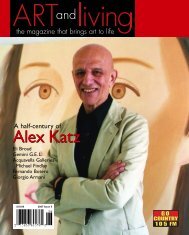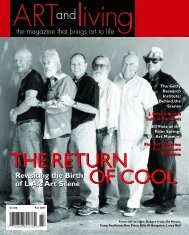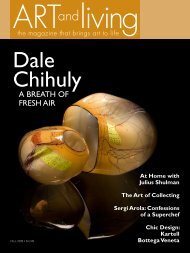Ed Ruscha Ed Ruscha Ed Ruscha - Art and Living
Ed Ruscha Ed Ruscha Ed Ruscha - Art and Living
Ed Ruscha Ed Ruscha Ed Ruscha - Art and Living
- No tags were found...
You also want an ePaper? Increase the reach of your titles
YUMPU automatically turns print PDFs into web optimized ePapers that Google loves.
artist profileFrancisco José de Goya y Lucientes, The Dog, 1820-23. Oil mural passedto canvas. Madrid, Museo del Prado.Francisco José de Goya y Lucientes, The Sleep of Reason Produces Monsters (Capricho 43),1797-98. Etching <strong>and</strong> aquatint, Madrid, Museo del Prado.Great He-Goat (or Witches Sabbath), which occupied thewhole of the lower left wall of Goya’s quinta, depicts a darkmaelstrom of a terrifying pagan ritual in broad, expressionisticstrokes. Mouths of witches <strong>and</strong> watching figures hang opengrotesquely in a manner that, like so many of Goya’s BlackPaintings <strong>and</strong> etchings, was largely anathema in painting at thetime, certainly in portraiture. The animalistic nature of thehuman organism is conveyed by the open mouth, as opposed tothe the proper, austere rictus of pursed lips required in traditionalrenderings of the time.His The Dog is devoid of l<strong>and</strong>scape <strong>and</strong> renders thepoignant <strong>and</strong> enigmatic image of a solitary dog staring up <strong>and</strong>out of the frame as if helpless, caught in the tide of someunknown force.The largely abstract image is ahead of its owntime, to say the least. Catalan surrealist Joan Miró asked to beshown The Dog <strong>and</strong> Velázquez’s Las Meninas on his last visit tothe Prado before his death. He gave both paintings equalweight by spending the same amount of time in front of each.Goya left a civil war-torn Spain in 1824 after being tried bythe Inquisition for obscenity for his painting of the salacious LaMaja Desnuda, 1797 – 1800. He was largely ostracised from exaltedSpanish social circles (which were his bread <strong>and</strong> butter) <strong>and</strong>,as a result, subsequently withdrew himself from public life.Goya died on April 16th, 1828 in Bordeaux at the age of82. His ashes were buried in the chapel of San Antonio de laFlorida, Madrid.Tourist Office of Spainin Los Angeleswww.spain.infoMadrid Board of Tourismwww.munimadrid.es/turismoMadrid Tourism Centerwww.esmadrid.comPrado Museumwww.museoprado.mcu.es68 2006 Issue 4






